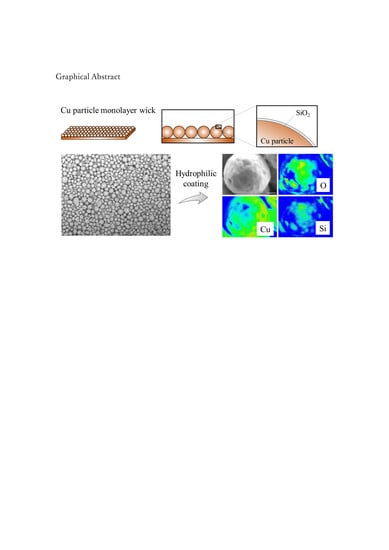Hydrophilic Coating of Copper Particle Monolayer Wicks for Enhanced Passive Water Transport
Abstract
:1. Introduction
2. Material and Methods
2.1. Fabrication of Cu Particle Monolayer
2.2. Characterization of Particle Monolayer Structure
2.3. Rate-of-Rise Experiment
3. Results and Discussion
3.1. Cu Particle Size Distribution
3.2. Contact Angle Measurement
3.3. Coating Condition
3.4. Wick Performance
4. Conclusions
Author Contributions
Funding
Acknowledgments
Conflicts of Interest
References
- Chen, X.; Ye, H.; Fan, X.; Ren, T.; Zhang, G. A review of small heat pipes for electronics. Appl. Therm. Eng. 2016, 96, 1–17. [Google Scholar] [CrossRef] [Green Version]
- Tang, H.; Tang, Y.; Wan, Z.; Li, J.; Yuan, W.; Lu, L.; Li, Y.; Tang, K. Review of applications and developments of ultra-thin micro heat pipes for electronic cooling. Appl. Energy 2018, 223, 383–400. [Google Scholar] [CrossRef]
- Wei, M.; He, B.; Liang, Q.; Somasundaram, S.; Tan, C.S.; Wang, E.N. Optimization and thermal characterization of uniform silicon micropillar based evaporators. Int. J. Heat Mass Transf. 2018, 127, 51–60. [Google Scholar] [CrossRef]
- Ranjan, R.; Patel, A.; Garimella, S.V.; Murthy, J.Y. Wicking and thermal characteristics of micropillared structures for use in passive heat spreaders. Int. J. Heat Mass Transf. 2012, 55, 586–596. [Google Scholar] [CrossRef] [Green Version]
- Shirazy, M.R.; Blais, S.; Fréchette, L.G. Mechanism of wettability transition in copper metal foams: From superhydrophilic to hydrophobic. Appl. Surf. Sci. 2012, 258, 6416–6424. [Google Scholar] [CrossRef]
- Hwang, G.; Nam, Y.; Fleming, E.; Dussinger, P.; Ju, Y.S.; Kaviany, M. Multi-artery heat pipe spreader: Experiment. Int. J. Heat Mass Transf. 2010, 53, 2662–2669. [Google Scholar] [CrossRef]
- Weibel, J.A.; Garimella, S.V.; North, M.T. Characterization of evaporation and boiling from sintered powder wicks fed by capillary action. Int. J. Heat Mass Transf. 2010, 53, 4204–4215. [Google Scholar] [CrossRef] [Green Version]
- Kim, M.; Kaviany, M. Multi-artery heat-pipe spreader: Monolayer-wick receding meniscus transitions and optimal performance. Int. J. Heat Mass Transf. 2017, 112, 343–353. [Google Scholar] [CrossRef]
- Kim, M.; Kaviany, M. Flow-boiling canopy wick for extreme heat transfer. Int. J. Heat Mass Transf. 2018, 117, 1158–1168. [Google Scholar] [CrossRef]
- Butt, H.-J.; Kappl, M. Surface and Interfacial Forces 2e; Wiley: Weinheim, Germany, 2018. [Google Scholar]
- Brinker, C.J.; Scherer, G.W. Sol-Gel Science: The Physics and Chemistry of Sol-Gel Processing; Academic Press: San Diego, CA, USA, 1990. [Google Scholar]
- Schneider, C.A.; Rasband, W.S.; Eliceiri, K.W. NIH Image to ImageJ: 25 years of image analysis. Nat. Methods 2012, 9, 671–675. [Google Scholar] [CrossRef] [PubMed]
- Kameya, Y. Wettability modification of polydimethylsiloxane surface by fabricating micropillar and microhole arrays. Mater. Lett. 2017, 196, 320–323. [Google Scholar] [CrossRef]
- Kameya, Y.; Yabe, H. Optical and Superhydrophilic Characteristics of TiO2 Coating with Subwavelength Surface Structure Consisting of Spherical Nanoparticle Aggregates. Coatings 2019, 9, 547. [Google Scholar] [CrossRef] [Green Version]
- Holley, B.; Faghri, A. Permeability and effective pore radius measurements for heat pipe and fuel cell applications. Appl. Therm. Eng. 2006, 26, 448–462. [Google Scholar] [CrossRef]
- Xiao, R.; Enright, R.; Wang, E.N. Prediction and Optimization of Liquid Propagation in Micropillar Arrays. Langmuir 2010, 26, 15070–15075. [Google Scholar] [CrossRef] [PubMed]
- Xu, R.; Di Guida, O.A. Comparison of sizing small particles using different technologies. Powder Technol. 2003, 132, 145–153. [Google Scholar] [CrossRef]
- De Gennes, P.-G.; Brochard-Wyart, F.; Quéré, D. Capillarity and Wetting Phenomena: Drops, Bubbles, Pearls, Waves; Springer Science & Business Media: Berlin/Heidelberg, Germany, 2004. [Google Scholar]
- Rinaldi, R.; Llovet, X. Electron Probe Microanalysis: A Review of the Past, Present, and Future. Microsc. Microanal. 2015, 21, 1053–1069. [Google Scholar] [CrossRef] [PubMed]
- Kaviany, M. Principles of Heat Transfer in Porous Media; Springer Science and Business Media LLC: Berlin/Heidelberg, Germany, 1995. [Google Scholar]









© 2020 by the authors. Licensee MDPI, Basel, Switzerland. This article is an open access article distributed under the terms and conditions of the Creative Commons Attribution (CC BY) license (http://creativecommons.org/licenses/by/4.0/).
Share and Cite
Kameya, Y.; Osonoe, R.; Anjo, Y. Hydrophilic Coating of Copper Particle Monolayer Wicks for Enhanced Passive Water Transport. Energies 2020, 13, 3294. https://doi.org/10.3390/en13123294
Kameya Y, Osonoe R, Anjo Y. Hydrophilic Coating of Copper Particle Monolayer Wicks for Enhanced Passive Water Transport. Energies. 2020; 13(12):3294. https://doi.org/10.3390/en13123294
Chicago/Turabian StyleKameya, Yuki, Ryota Osonoe, and Yuto Anjo. 2020. "Hydrophilic Coating of Copper Particle Monolayer Wicks for Enhanced Passive Water Transport" Energies 13, no. 12: 3294. https://doi.org/10.3390/en13123294





